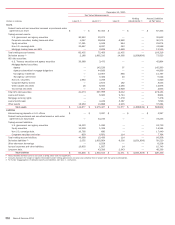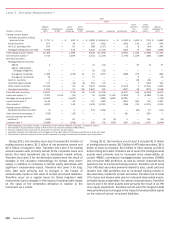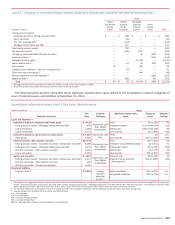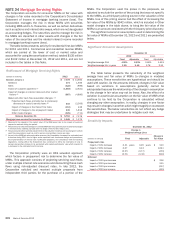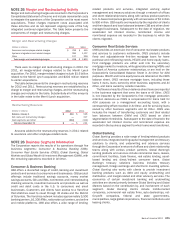Bank of America 2012 Annual Report Download - page 267
Download and view the complete annual report
Please find page 267 of the 2012 Bank of America annual report below. You can navigate through the pages in the report by either clicking on the pages listed below, or by using the keyword search tool below to find specific information within the annual report.
Bank of America 2012 265
and interest rate correlations are measured between curves and
across the various tenors on the same curve, the range of potential
values can include both negative and positive values. For the
correlation (IR/IR) range, the exposure represents the valuation
of interest rate correlations on less liquid pairings and is
concentrated at the upper end of the range. For the correlation
(FX/IR) range, the exposure is the sensitivity to a broad mix of
interest rate and foreign exchange correlations and is distributed
evenly throughout the range. For long-dated inflation rates and
volatilities as well as long-dated volatilities (FX), the inputs are
concentrated in the middle of the range.
Sensitivity of Fair Value Measurements to Changes in
Unobservable Inputs
Loans and Securities
For instruments backed by residential real estate assets,
commercial real estate assets, and commercial loans, debt
securities and other, a significant increase in market yields, default
rates or loss severities would result in a significantly lower fair
value for long positions. Short positions would be impacted in a
directionally opposite way. The impact of changes in prepayment
speeds would have differing impacts depending on the seniority
of the instrument and, in the case of CLOs, whether prepayments
can be reinvested.
For closed-end ARS, a significant increase in discount rates
would result in a significantly lower fair value. For student loan and
municipal ARS, a significant increase in projected tender price/
refinancing levels would result in a significantly higher fair value.
Structured Liabilities and Derivatives
For credit derivatives, a significant increase in market yield,
including spreads to indices, upfront points (i.e., a single upfront
payment made by a protection buyer at inception), credit spreads,
default rates or loss severities would result in a significantly lower
fair value for protection sellers and higher fair value for protection
buyers. The impact of changes in prepayment speeds would have
differing impacts depending on the seniority of the instrument and,
in the case of CLOs, whether prepayments can be reinvested.
Structured credit derivatives, which include tranched portfolio
CDS and derivatives with derivative product company (DPC) and
monoline counterparties, are impacted by credit correlation,
including default and wrong-way correlation. Default correlation is
a parameter that describes the degree of dependence among
credit default rates within a credit portfolio that underlies a credit
derivative instrument. The sensitivity of this input on the fair value
varies depending on the level of subordination of the tranche. For
senior tranches that are net purchases of protection, a significant
increase in default correlation would result in a significantly higher
fair value. Net short protection positions would be impacted in a
directionally opposite way. Wrong-way correlation is a parameter
that describes the probability that as exposure to a counterparty
increases, the credit quality of the counterparty decreases. A
significantly higher degree of wrong-way correlation between a DPC
counterparty and underlying derivative exposure would result in a
significantly lower fair value.
For equity derivatives, equity-linked long-term debt (structured
liabilities) and interest rate derivatives, a significant change in
long-dated rates and volatilities and correlation inputs (e.g., the
degree of correlation between an equity security and an index,
between two different interest rates, or between interest rates and
foreign exchange rates) would result in a significant impact to the
fair value; however, the magnitude and direction of the impact
depends on whether the Corporation is long or short the exposure.
Nonrecurring Fair Value
The Corporation holds certain assets that are measured at fair
value, but only in certain situations (for example, impairment) and
these measurements are referred to herein as nonrecurring. These
assets primarily include LHFS, certain loans and leases, and
foreclosed properties. The amounts below represent only balances
measured at fair value during 2012, 2011 and 2010, and still held
as of the reporting date.
Assets Measured at Fair Value on a Nonrecurring Basis
December 31
2012 2011
(Dollars in millions) Level 2 Level 3 Level 2 Level 3
Assets
Loans held-for-sale $ 5,692 $ 1,136 $ 2,662 $ 1,008
Loans and leases 21 9,184 9 10,629
Foreclosed properties (1) 33 1,918 — 2,531
Other assets 36 12 44 885
Gains (Losses)
(Dollars in millions) 2012 2011 2010
Assets
Loans held-for-sale $ (8) $ (181) $ 174
Loans and leases (2) (3,116) (4,813) (6,074)
Foreclosed properties (188) (333) (240)
Other assets (16) — (50)
(1) Amounts are included in other assets on the Corporation’s Consolidated Balance Sheet and
represent fair value and related losses on foreclosed properties that were written down
subsequent to their initial classification as foreclosed properties.
(2) Losses represent charge-offs on real estate-secured loans.



